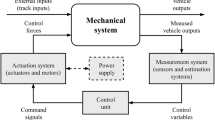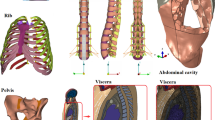Abstract
The lateral vibration of the car body affects the lateral stability of high-speed trains (HSTs), and the aim of this study is to design a good control strategy to decrease the lateral vibration of the car body. First, the Maxwell model of the anti-yaw damper was transformed into a Voigt model by the equivalence method, and a modified 17-degree-of-freedom (DOF) lateral vibration model that includes the anti-yaw damper was established. After the design difficulty and control accuracy of the control strategy were weighed, the lateral and yaw motions of the wheelsets were regarded as disturbances, and a disturbance observer of wheelset motions was designed to simplify the 17-DOF model to a 9-DOF lateral vibration model. Second, a model predictive control (MPC) strategy for HST lateral vibration was designed, and the effects of the key parameters on the lateral vibration acceleration of the HST car body and on the iterative computation time of the MPC strategy were studied. In addition, a conditionally triggered model predictive control (CMPC) strategy was proposed. Last, the control effects of the CMPC strategy under the working conditions of speed change, turnout passage, and aerodynamic load were studied by simulation, which verified the validity of the proposed model and control strategy.
Similar content being viewed by others
References
T. Jin et al., Theoretical and experimental investigation of a stiffness-controllable suspension for railway vehicles to avoid resonance, International Journal of Mechanical Sciences, 187 (2020) 105901.
Q. Zhu, L. Li, C. Chen, C. Liu and G. Hu, A low-cost lateral active suspension system of the high-speed train for ride quality based on the resonant control method, IEEE Transactions on Industrial Electronics, 65(5) (2018) 4187–4196.
L. Zong, X. Gong, S. Xuan and C. Guo, Semi-active H∞control of high-speed railway vehicle suspension with magnetor-heological dampers, Vehicle System Dynamics, 51(5) (2013) 600–626.
X. Wang, D. Huang, N. Qin, C. Chen and K. Zhang, Modeling and second-order sliding mode control for lateral vibration of high-speed train with MR dampers, IEEE Transactions on Intelligent Transportation Systems, 23(8) (2022) 10299–10308.
D. Huang, C. Chen, T. Huang, D. Zhao and Q. Tang, An active repetitive learning control method for lateral suspension systems of high-speed trains, IEEE Transactions on Neural Networks and Learning Systems, 31(10) (2020) 4094–4103.
Y. Yan, J. Zeng, C. Huang and T. Zhang, Bifurcation analysis of railway bogie with yaw damper, Archive of Applied Mechanics, 89(7) (2019) 1185–1199.
Z. Xia, J. Zhou, D. Gong, W. Sun and Y. Sun, Research on low-frequency lateral sway of railway vehicle body based on modal continuous tracking, Journal of the China Railway Society, 40(12) (2018) 46–54.
X. Zheng, A. Zolotas and R. Goodall, Combined active suspension and structural damping control for suppression of flexible bodied railway vehicle vibration, Vehicle System Dynamics, 58(2) (2020) 198–228.
Z. Gao, B. Tian, D. Wu and Y. Chang, Study on semi-active control of running stability in the high-speed train under unsteady aerodynamic loads and track excitation, Vehicle System Dynamics, 59(1) (2021) 101–114.
Y. Liao, Z. Chen, Y. Liu and Y. Zhao, Design and simulation analysis of a continuous mixed control for high-speed train suspension systems, Journal of Vibration and Shock, 40(6) (2021) 235–242.
B. A. Negash, W. You, J. Lee, C. Lee and K. Lee, Semi-active control of a nonlinear quarter-car model of hyperloop capsule vehicle with skyhook and mixed skyhook-acceleration driven damper controller, Advances in Mechanical Engineering, 13(2) (2021) 1–14.
S. Yang, Y. Zhao, Y. Liu, Y. Liao and P. Wang, A new semi-active control strategy on lateral suspension systems of highspeed trains and its application in HIL test rig, Vehicle System Dynamics, 61(5) (2023) 1317–1344.
Y. Wu, J. Zeng, H. Shi, B. Zhu and Q. Wang, A hybrid damping control strategy for high-speed trains running on existing tracks, Journal of Low Frequency Noise Vibration and Active Control, 41(3) (2022) 1258–1271.
S. Bhardawaj, R. C. Sharma and S. K. Sharma, Development of multibody dynamical using MR damper based semi-active bio-inspired chaotic fruit fly and fuzzy logic hybrid suspension control for rail vehicle system, Proceedings of the Institution of Mechanical Engineers Part K-Journal of Multi-Body Dynamics, 234(4) (2020) 723–744.
Q. Zhu, J. Ding and M. Yang, LQG control based lateral active secondary and primary suspensions of high-speed train for ride quality and hunting stability, IET Control Theory and Applications, 12(10) (2018) 1497–1504.
Y. Zeng, W. Zhang and D. Song, Lateral-vertical coupled active suspension on railway vehicle and optimal control methods, Vehicle System Dynamics, 60(1) (2020) 258–280.
E. D. Gialleonardo, A. Facchinetti and S. Bruni, Control of an integrated lateral and roll suspension for a high-speed railway vehicle, Vehicle System Dynamics, 61(2) (2023) 472–498.
Z. Li, Y. Ding, H. Yang and J. Liu, Generalized predictive control tuning for high-speed train based on controller matching method, Oumal of the China Railway Society, 40(9) (2018) 82–89.
Z. Li, L. Zhou, H. Yang and M. Ye, lterative learning control method for EMUs based on predictive control, Journal of Traffic and Transportation Engineering, 23(1) (2023) 280–290.
Y. Wang, S. Zhu, S. Li, L. Yang and B. D. Schutter, Hierarchical model predictive control for on-line high-speed railway delay management and train control in a dynamic operations environment, IEEE Transactions on Control Systems Technology, 30(6) (2022) 2344–2359.
H. Zhang, S. Li, Y. Wang, Y. Wang and L. Yang, Real-time optimization strategy for single-track high-speed train rescheduling with disturbance uncertainties: A scenario-based chance-constrained model predictive control approach, Computers & Operations Research, 127 (2021) 105135.
X. Xu, J. Peng, R. Zhang, B. Chen, F. Zhou, Y. Yang, K. Gao and Z. Huang, Adaptive model predictive control for cruise control of high-speed trains with time-varying parameters, Journal of Advanced Transportation, 2019 (2019) 1–11.
Z. Sun, L. Dai, K. Liu, D. V. Dimarogonas and Y. Xia, Robust self-triggered MPC with adaptive prediction horizon for perturbed nonlinear systems, IEEE Transactions on Automatic Control, 64(11) (2019) 4780–4787.
L. Dai, M. Cannon, F. Yang and S. Yan, Fast self-triggered MPC for constrained linear systems with additive disturbances, IEEE Transactions on Automatic Control, 66(8) (2021) 3624–3637.
L. Lu and J. M. Maciejowski, Self-triggered MPC with performance guarantee using relaxed dynamic programming, Automatica, 114 (2020) 108803.
L. Lu, D. Limon and I. Kolmanovsky, Self-triggered MPC with performance guarantee for tracking piecewise constant reference signals, Automatica, 142 (2022) 110364.
Y. Yao, X. Chen, H. Li and G. Li, Suspension parameters design for robust and adaptive lateral stability of high-speed train, Vehicle System Dynamics, 61(4) (2023) 943–967.
W. Zhai, Vehicle-Track Coupled Dynamics, China Railway Press, Beijing, China (2015).
W. Chen, D. J. Ballance, P. J. Gawthrop and J. O’Reilly, A nonlinear disturbance observer for robotic manipulators, IEEE Transactions on Industrial Electronics, 47(4) (2000) 932–938.
Y. Danayiyen, K. Lee, M. Choi and Y. I. Lee, Model predictive control of uninterruptible power supply with robust disturbance observer, Energies, 12(15) (2019) 2871.
N. N. Nam, N.-D. Nguyen, C. Yoon and Y. I. Lee, Disturbance observer-based robust model predictive control for a voltage sensorless grid-connected inverter with an LCL filter, IEEE Access, 9 (2021) 109793.
X. Li, Q. Yang, W. Tian, P. Karamanakos and R. Kennel, A dual reference frame multistep direct model predictive current control with a disturbance observer for SPMSM drives, IEEE Transactions on Power Electronics, 37(3) (2021) 2857–2869.
J. Yang, W. Zheng, S. Li, B. Wu and M. Cheng, Design of a prediction accuracy enhanced continuous-time MPC for disturbed systems via a disturbance observer, IEEE Transactions on Industrial Electronics, 62(9) (2015) 5807–5816.
GB/T 5599-2019, Specification for Dynamic Performance Assessment and Testing Verification of Rolling Stock, China National Bureau of Standards, China (2019).
W. Zhang, R. Luo, C. Song and J. Fan, Hunting control of high speed train using traction motor as dynamic absorber, Journal of Traffic and Transportation Engineering, 20(5) (2021) 125–134.
P. Wang, S. Wang, D. Yang and D. Si, Study on adaptability of high-speed turnout under condition of designed speed, Journal of the China Railway Society, 44(6) (2022) 75–83.
A. Yang, F. Yang, J. Sun, H. Diao, J. Xu, H. Li and W. Chang, Study on dynamic management limit of geometric irregularities in turnout area of high speed railway, Railway Engineering, 62(10) (2022) 35–39.
D. Wang, C. Chen and S. Xiong, Lateral stability fuzzy control of high-speed train under aerodynamic load, Machinery Design & Manufacture (12) (2020) 87–90.
Acknowledgments
This work was supported by the National Natural Science Foundation of China (Nos. U2034210, 51975487, and 52372402).
Author information
Authors and Affiliations
Corresponding authors
Additional information
Ruqiang Mou received his M.A. degree in Mechatronic Engineering from Sichuan University in 2016, where he is currently pursuing the Ph.D. degree in Mechatronic Engineering from Southwest Jiaotong University, Chengdu, China. He is a lecturer of the Department of Automation Engineering, The Engineering & Technical College of Chengdu University of Technology. His research interests include robot mechanism and control, vehicle system dynamics and vibration control, mechatronics design.
Chunjun Chen received the Ph.D. degree from Southwest Jiaotong University in 2006 and the M.A. degree from University of Electronic Science and Technology of China in 1993. He is a Professor of School of Mechanical Engineering, Southwest Jiaotong University, Director of Department of Measure-ment and Control and Mechano-electronic Measurement and Control Laboratorial Center and Deputy Director of the Technology and Equipment of Rail Transit Operation and Maintenance Key Laboratory of Sichuan Province. His research interests include vibration, noise and aerodynamics of high-speed trains, traffic equipment, electromechanical systems, advanced control and measurement theory, electromechanical control and measurement system.
Chaoyue Chen is currently pursuing the Ph.D. degree in Mechatronic Engineering from Southwest Jiaotong University, Chengdu, China. His research interests include vehicle system dynamics, mechanical system dynamics and advanced control strategy.
Yaowen Zhang received the B.S. degree in mechanical engineering from Southwest Jiaotong University, Chengdu, China, in 2020, where he is currently pursuing the Ph.D. degree in Mechatronic Engineering from Southwest Jiaotong University. His current research interests include semi-active control and vehicle system dynamics.
Rights and permissions
About this article
Cite this article
Mou, R., Chen, C., Chen, C. et al. Analysis and control of high-speed train lateral vibration on the basis of a conditionally triggered model predictive control strategy. J Mech Sci Technol 38, 1703–1717 (2024). https://doi.org/10.1007/s12206-024-0307-6
Received:
Revised:
Accepted:
Published:
Issue Date:
DOI: https://doi.org/10.1007/s12206-024-0307-6




